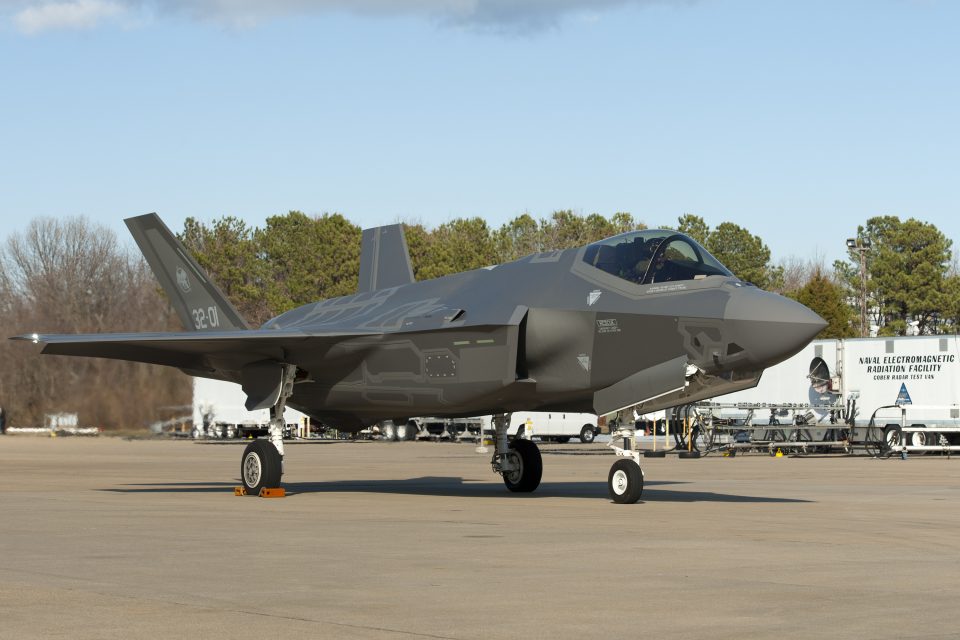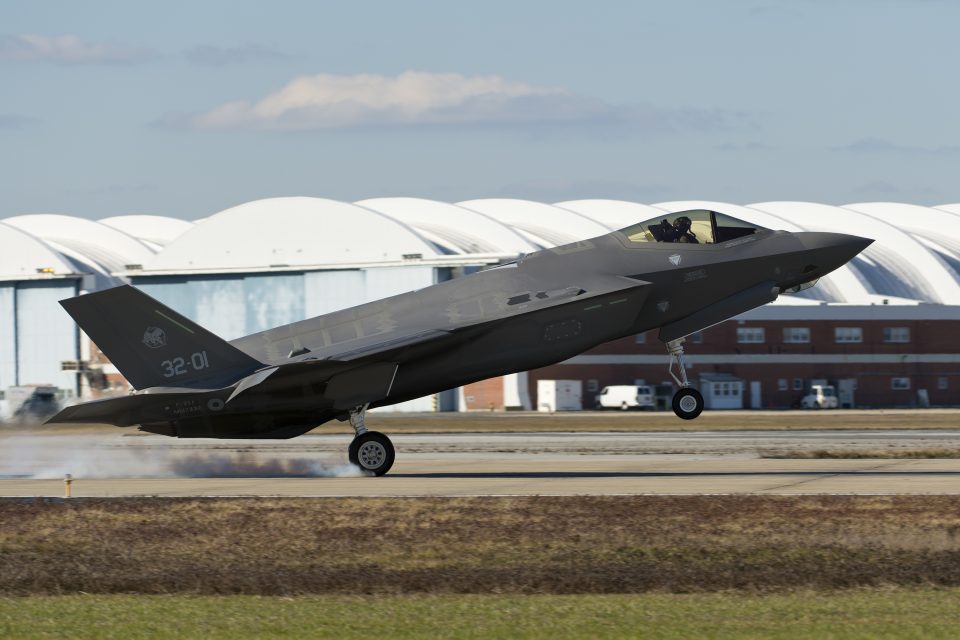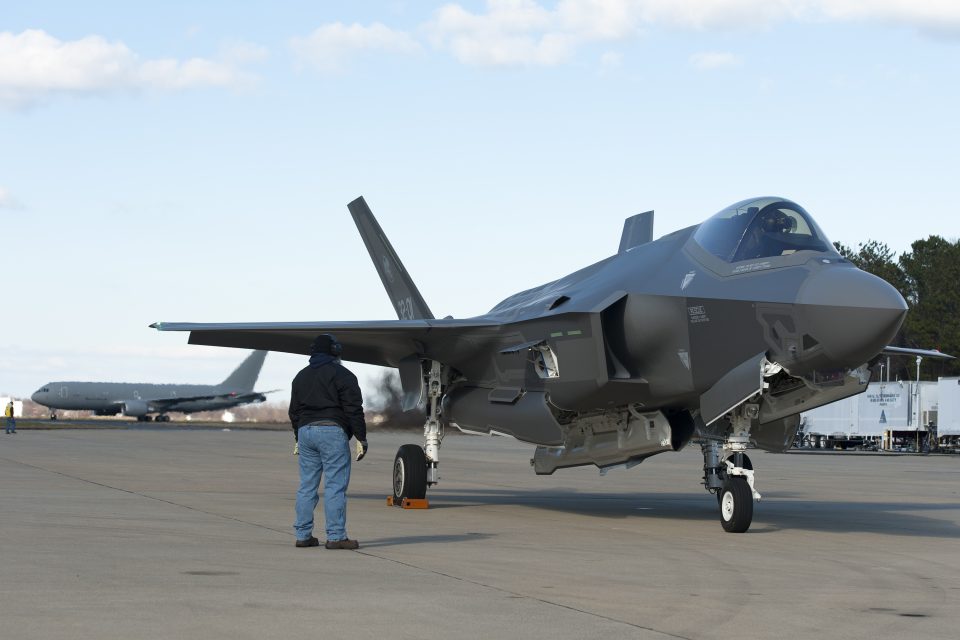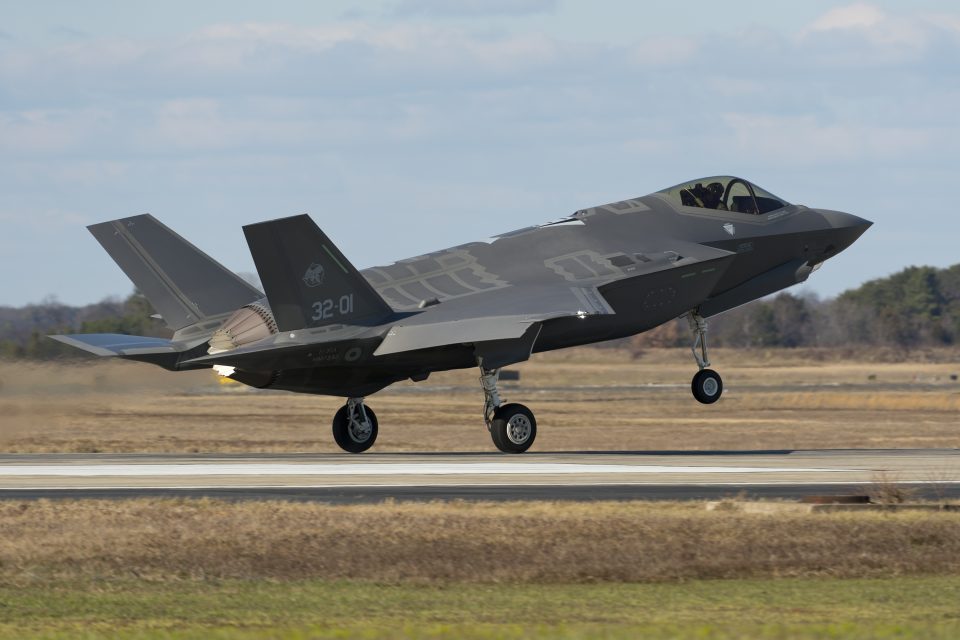2016-02-06 By Robbin Laird and Ed Timperlake
Last week saw one of the worst snow storms ever experienced in the Washington DC area.
And the weather the last couple of days have been rough as well with storms and heavy rain.
But yesterday after a stormy beginning, the sun peeked through at Naval Air Station, Pax River, and like “Lucky Lindy” landing “The Spirit of Saint Louis” at Le Bourget in France many years ago, all present witnessed an aviation historic first.
At 1430 on February 5th, the first Italian made F-35A flew into the pattern at Patuxent River Naval Air Station, Maryland and touched down. Known to all Naval Aviators as “Pax” this historic flight of an Italian fighter pilot, wearing his cold water survival suit, flew the single seat, single engine F-35A flew in the dead of winter over the North Atlantic.
The Italian AF combat fighter pilot’s call sign was “Ninja” and as a Major he was also a very accomplished test pilot and former Tornado reconnaissance pilot.
He flew his Lightning II pushing against a 120 knot jet stream essentially hand flying the aircraft the entire way feet wet in a formation with a tanker in the clouds while refueling in the turbulent air of the North Atlantic.
It was remarkable flying that in his debrief Ninja modestly understated with a grin that he was just doing what the mission required.
Pax River is a famous Navy/Marine aviation test center airfield and within the global F-35 community functions in an integrated manner with the world famous USAF aviation test center at Edwards AFB California.
Together these bases are the home of aviators that Tom Wolfe’s famous book describes as having “The Right Stuff.”
And on February 6th “Ninja” was at the top of Wolfe famous aviation pyramid in doing something no other pilot has done while flying the newest F-35 in world. Ninja was very modest but it was a true day for Italian aviation pride and a reason to celebrate.
Historically, allies and partners who operated U.S.-generated fighter aircraft would do so sequentially over time as the type/model/series progressed, with U.S. fighter pilots first flying the newest jets and then allies next as production was generated off of U.S. lines.
For example, the first flight by the U.S. of the F-16 was in 1977, however, it took until 2001 for the first USAF F-16s to be introduced into the Italian AF. Under the terms of a USAF and Italian AF agreement named the “Peace Caesar” program was a lease of F-16s to make up for shortfalls in Typhoons in the Italian Air Force fleet.
The landing a Pax was the culmination of a very important and visionary effort by Italy.
Four years ago, on an empty field at the Cameri Air Base near Milan Italy, Italian leaders began development of an F-35 final assembly plant. In just four years Cameri became the first F-35 Final Assembly Facility (FACO) outside of the United States. The Japanese are currently assemblying their first F-35 in Japan currently, and came to Cameri as part of their learning process.
At Cameri, Italian industrial defense workers are both building wings for other global partners in the F-35 program, in fact, the first Cameri fabricated “wings” were integrated onto a USAF F-35 recently.
They are building full up and up planes (airframe and systems) for themselves and the Dutch.
The first F-35 came off of the line in early 2015.
On Sept. 7, 2015 the first F-35A assembled outside the US, made its very first flight from Cameri airbase.
Later in 2015, the Italian AF took delivery of AL-2, the second F-35 built in Italy.
In stark contrast to the F-16 experience, the first F-35A to cross the Atlantic was flown by Italy not the USAF.
Put in blunt terms, the Italians and the partners are flying the most advanced US combat jet in current production at the same time as the US services, which provides a unique moment in history and a clear opportunity for shaping new global capabilities.
The landing of AF-01, which flew first in Italy in September, was by one of the Italian pilots trained at Luke AFB in the Fall and highlighted the remarkable progress of the program.
The flight from Cameri to Pax River added some miles to the program which is nearly 50,000 hours flown by the fleet to date.
We previously interviewed Ninja when he flew the F-35 at Luke in the Fall of 2015.
During that interview, he highlighted the unique international quality of the program:
Question: What does an integrated F-35 fleet bring to coalition combat, from your point of view?
Answer: We will write the TTPs together.
The commonality from the very beginning will be built into any operation which you do with your coalition partners.
And we are working from the ground up with the USAF, which is different as well from before.
We have made significant progress in the past two years, which is often not grasped by those not involved in the program.
And let me return to the point we discussed earlier about the difference between multi-mission and multi-tasking and the impact on operations.
You do not have to switch your configurations for air-to-air to air-to-ground or whatever the mission for which you have been pre-configured.
You can do what you need to do with the situational awareness built into the jet and the fleet and then fly to the mission.
During the Luke interview, the Italian pilots underscored the importance of being able to work with different partners and services in order to shape the way ahead with the aircraft, the fleet and preparation for combat.
Notably, an F-35 A, in this case an Italian F-35A, came to Pax River for electromagnetic wave form testing, although this is a navy test facility. In our forthcoming interview with the head of F-35 testing at Pax River we will focus on how Pax and Edwards work together and how testing is being shaped quite differently from how it is widely perceived.
And Ninja also thanked the Marines for their help in shaping his way ahead with regard to the flight.
He specially mentioned in his interview that the Marines who had come to Pax River to fly over the Atlantic to Farnbourgh in 2014, but did not do so, and in turn flew back to Yuma, helped him prepare for his transatlantic flight.
And he is more than willing to pay back the Marines with advice based on his experience.
“I will give them all the help they need to do this.
Semper fidelis!”
After Ninja landed, reporters had a chance to discuss the flight with Ninja, and we will provide a full report on that interview in the near future, for it was comprehensive and wide ranging in discussing the jet and its clear capabilities right now resident in the aircraft.
It should be noted that the jet flew with a Eurofighter, an Italian KC-767 tanker and with two C-130s for support for air/sea rescue in case needed. Flying across the Atlantic in winter against heavy head winds is no picnic, but the jet not only had no “maintenance discrepancies” in both legs, but flew with ease and comfort according to Ninja.
Although the jet has just enough fuel, winds permitting, to fly from the Azores to Canada without refueling, it was refueled in flight four times for safety and security. It was refueled twice in the clouds, and the stability of the computer assisted flight controls allowed the aircraft to do the air refueling extremely well.
Relying on the cockpit fusion engine and his second generation helmet using the DAS system built into the jet the pilot was able to see all members of the formation even through the clouds, including the rescue C-130s flying below him.
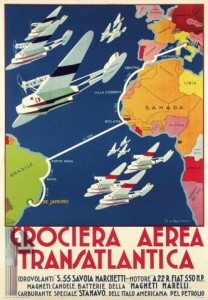
He shifted from autopilot to hand flying as appropriate throughout the flight of seven hours from the Azores.
He emphasized that the plane was rock solid and a dream to fly.
“I had no maintenance gripes” and as we previously saw at Nellis AFB he could adjust the very flexible cockpit screens to provide fused 360 situational awareness (SA) data which he needed to manage the flight across the Atlantic in formation.
The helmet was very comfortable and worked well; and the ergonomics were excellent for the flight as he was comfortable throughout the flight.
It was noteworthy that he was doing all of this after having only 50 hours of flight time in the jet!
Although accompanied by much more attention and publicity, the famous formation flight by Balbo and his mates with 12 hydroplanes from Rome to Rio de Janeiro, the flight by a Ninja more than 70 years later was also a first of historic significance.
But in this case, an Italian delegation, and five journalists were all that were present welcoming Ninja and his AF-01 at Pax River to greet him.
AL-1 Arrival at NAS Patuxent River Naval Air Station from SldInfo.com on Vimeo.
Credit Video: Lockheed Martin, February 5, 2016
Editor’s Note:The first slideshow shows the landing of the AL-1 at Pax River.
The second slideshow shows the first flight of AL-1 in September 2015 at Cameri.
Also see the following:
https://www.sldinfo.com/shaping-the-future-of-italian-airpower/
http://breakingdefense.com/2015/10/italys-air-force-chief-on-the-f-35-eurofighter-and-predator/
https://www.sldinfo.com/the-second-italian-built-f-35-takes-to-the-skies/
https://www.sldinfo.com/italian-f-35-pilots-first-flight/
The video below provides an interview with the Italian pilots, the first one is “Ninja” after their first flight at Luke AFB:
First Italian F-35 Flight English Interviews from SldInfo.com on Vimeo.
11/07/2015: Two Italian pilots completed their first flights in the F-35 at Luke Air Force Base, Arizona.
One of the jets used was an Australian F-35, highlighting the integration of the F-35 global partners.
Credit: 56th Fighter Wing Public Affairs
11/05/15
The link below provides a 1930 video from British Pathe of the flight by Balbo and his crew:
“Italy – First “Formation” Atlantic Flight. 12 giant Hydroplanes set out on great adventure from Rome to Rio de Janeiro, with General Balbo, Italian Air Minister, in command.”
A hand points to a route drawn on a map depicting the route General Italo Balbo and his men will take from Italy to Brazil. Balbo poses with his crews.
A S.55A twin-hulled flying boat is wheeled out on a dolly in preparation for launch.
The crews attend a religious Mass before departure.
Men hoist a flag while another man is playing the trumpet.
The S.55As start up and begin taking off.
https://timeandnavigation.si.edu/multimedia-asset/first-formation-atlantic-flight-run-time-227


